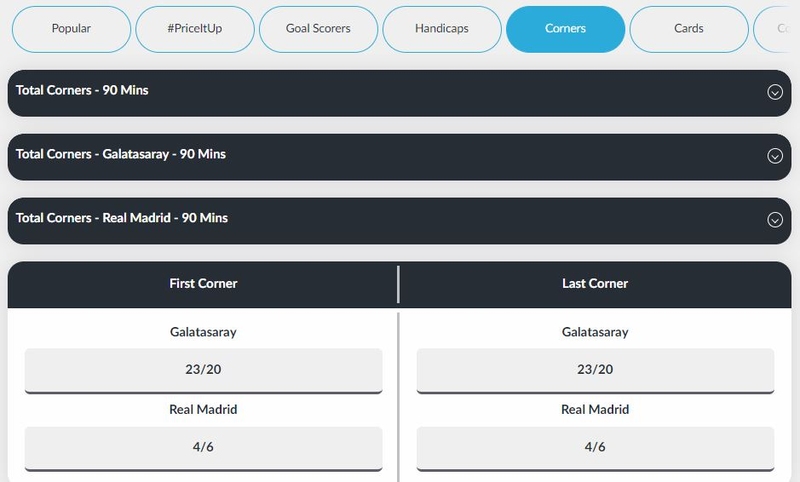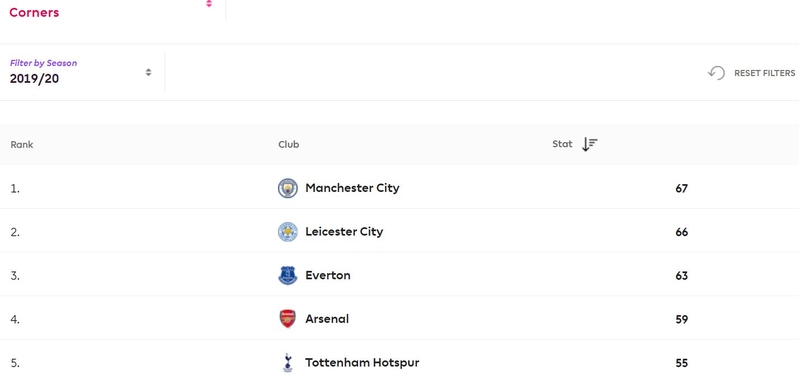 The emergence of online and mobile betting has totally changed the way that we bet on sports like football. It has lead to a huge influx in markets and as a result we now more betting choice than ever.
The emergence of online and mobile betting has totally changed the way that we bet on sports like football. It has lead to a huge influx in markets and as a result we now more betting choice than ever.
Corner betting is one of the biggest beneficiaries of the boom and now there are a plethora of different corner markets to choose from. This influx comes on the back of a huge number of bets that are placed on corners for each and every match. It’s at the point now where there are entire websites dedicated to just this market, with a staggering range of archived stats and data from teams all over the world.
Your standard betting market for corners is simply betting on the number of corners that are taken in the match. This is a cumulative number that includes both teams. The bookmaker often sets a line and then you bet on the over, under, or sometimes the exact number of corners.
Other corner betting markets

Here is selection of what you can expect from the various different corner betting markets and how they work:
- Total Corners – This market is the total number of corners for the match. Instead of it being an over or under number, they are grouped, and you can pick from these groups. Usually they include: under 6, 6-8, 9-11, 12-14 and then over 14. The two extremes for these markets will be the highest priced and the brackets will change depending on the two teams in question.
- Alternative corners – The alternative corners market is where you can bet on the over, under, or exact number of a huge range of corners. Totals can go from 3 right up to 17 and you’ve got the chance to bet on each market in between. The even money bet for most of these is around 9, which is found in the main market.
- Corners 2-way – The 2-way betting market is where it takes the ‘exact’ number of corners bet away from the main market. The bookmaker sets a line and then you choose the over or under from that line. It’s worth noting the line is a fraction, so there are no ties. For example; over or under 9.5 corners.
- 1st/ 2nd half corners – This market is where you bet on the total number of corners per half instead of for the whole game. Again, the market is based on the cumulative number for both teams.
- Corner match bet – This market is where you bet on the team with the most corners. You can also select a tie for this as well.
- Corner handicap – This is where a handicap is applied to one team. This means that a number of corners will either be removed or added to the total after the match, depending on how you bet; so a handicap of +2 will add 2 corners on to the actual number.
- Corner race – For this you are betting on the team to reach a certain number of corners first. So, it might be one team to hit 5 corners before the other. A wide range of outcomes can be chosen from this market alone.
- First/last match corner – Here you will be betting on the team to take either the first or the last match corner. These are sperate markets, so you don’t need to choose the first and the last corner taken.
- Multi corners – This is one the newest corner betting markets and you need to select the over or under on a line set by the bookmaker. However, to get this number we have to multiply the number of corners in the first half by the number of corners in the second. So, if there were 5 corners in 1st half and 4 in 2nd half, that would make 25 corners total.
The sheer volume and range of bet types here highlights just how popular the market has become. If there was little to no demand for them, then you wouldn’t see even a fraction of the number of markets that you can access at most major bookmakers.
Corner rules
 The corner market is pretty straightforward, but one thing that you need to understand is that the corner has to be taken and not just awarded before it is counted. For example, if a corner is awarded near the end of the match and the player goes over the take that corner, but the referee blows for full time before the ball is back into play, then this will not count as a corner.
The corner market is pretty straightforward, but one thing that you need to understand is that the corner has to be taken and not just awarded before it is counted. For example, if a corner is awarded near the end of the match and the player goes over the take that corner, but the referee blows for full time before the ball is back into play, then this will not count as a corner.
It’s also worth noting that corners only count within normal time of a match. So, for cup games, the bet would be settled after 90 minutes plus injury time, and wouldn’t include extra time.
Lastly, any retaken corners will only count as one corner. This occurs when the corner comes in and the referee blows their whistle as they weren’t ready for example, so the player needs to retake.
Corner betting strategy
As we stated earlier, there are websites dedicated solely to corner betting, so it’s big business for bookmakers now. Like pretty much all forms of football betting though, there is strategy that you can apply to corner betting and here are some of our best tips.
Team tactics and playing styles
 One of the best ways to get started with corner betting is to become hyper aware of how teams play and if their style is set up to create more corners in a game. You often find that teams that are massive favourites will get a lot of corners in a game, because they dominate the field and spend a lot of time in their opponent’s half – which is why they are the favourites.
One of the best ways to get started with corner betting is to become hyper aware of how teams play and if their style is set up to create more corners in a game. You often find that teams that are massive favourites will get a lot of corners in a game, because they dominate the field and spend a lot of time in their opponent’s half – which is why they are the favourites.
You might look at a team like Manchester City in the Premier League playing a team like Southampton at home and then decide that Man City are the much stronger team. They are going to dominate the game in terms of both possession and territory. You would therefore expect a high number of corners for Man City, although of course the flip side to that is that Southampton will create very few, so bear that in mind for cumulative bets.
Another good little trick is to find teams that play with two wide players. Wingers are pretty rare these days, especially right footed wingers playing on the right and left footed wingers playing on the right (the modern way is to have them the other way around). The reason that this is important is that they aren’t going to cut back in, so there is more chance of taking a deflection and going out for a corner. If they cut back in, they are hitting against defenders, so the ball tends to go the other way.
Apply corner stats

The depth of corner stats now is dizzying and definitely a tool that everyone should use. There are plenty of sites where you can get stats such as the total number of corners and total corners per team for free. There are also plenty of sites that offer much deeper stats, such as time, game situation (great for in-play betting), and even individual player data within those teams.
We can use both total corners per match and total team corners together, but they are very different. You need to remember that total corners per match will include their opponents as well. If they are a poor team they may have a high number of corners per match, but realistically it’s because they are beaten most weeks. This is fine, but if they are playing a similarly poor team then they may have a similar trend, meaning that whilst both numbers are high against stronger teams they don’t actually get many corners for themselves. Thus, when playing each other, the number of corners is likely to be lower than with most of their other games.
Corners per team is probably a safer stat to use, but definitely look at both to try and get a reference point.
 The easiest thing to do is take both stats for both teams in question, add the numbers together, and then divide by 2 to get a possible average for that game. For example, if one team averaged 9 combined corners per game and the other average 8, you add them together to make 17 and then divide by 2 to get 8.5 corners for that game.
The easiest thing to do is take both stats for both teams in question, add the numbers together, and then divide by 2 to get a possible average for that game. For example, if one team averaged 9 combined corners per game and the other average 8, you add them together to make 17 and then divide by 2 to get 8.5 corners for that game.
Next, do the same for the total corners per team and see what number that brings in. Let’s say that one team averages 5 and the other averages 4 in our example. That combines to make 9 team corners per game.
We now have two numbers; 8.5 total corners on average and 9 combined between the two. This means that we could pretty safely bet on the over 8 corners for this match and with it be mathematically sound based on our research.
As a final point it’s important to also include home and away data for your numbers. Teams often play very differently at home than they do away from home, and this means that the number of corners can see a huge difference.
![]()
Looking at the text above, FC Tokyo show a great example of what we are talking about here. Their overall total corners is 11.18 for league games, but at home they average 12.30 corners and away they average just 9.57. You would need to make sure you took this into account if you were betting on them as the home and away numbers make significantly different reading.
In-play betting often more successful
![]() In-play betting was made for markets like corner betting. The outcome of these markets can be so dependent on how a game is taking shape that it’s best to be ready and able to react within the in-play betting markets rather than just going with the numbers pre match.
In-play betting was made for markets like corner betting. The outcome of these markets can be so dependent on how a game is taking shape that it’s best to be ready and able to react within the in-play betting markets rather than just going with the numbers pre match.
There are a few reasons why we like to bet in-play with corners:
- Whilst we don’t need goals for this market, they actually have a knock on effect as to how the corner market will play out. What you usually find is that the team who has scored will begin to sit back and absorb pressure from the other team. This means they are less likely to attack and therefore less likely to win corners. Our play here would be start backing the opposition team-only markets.
- Tracking favourites is another deal breaker when it comes to corner betting. If a favourite is winning then they average around 5 corners per game, if they are losing this number jumps to 8. For example, if Man city go 1-0 down you can bet your bottom dollar they are going to come out firing on all cylinders and eventually they will create chances. With chances, often come corners. Our play is to get on the pre-match favourites if they go behind or take a higher range of corners for the ‘over’ bet.
- A follow up from 2 is that if favourites aren’t able to get an early breakthrough they become more desperate and push harder. A 0-0 game between top and bottom in the league at half time is a sure-fire sign there will be corners in that second half.
- Backing favourites when they go behind has a similar effect. The number of corners is going to increase even more as they won’t just be pushing for one goal here, they will want at least 2 in a game that they think they should be winning.
Target teams with good corner/set piece takers

On the slip side of that, you want to really be avoiding those that are looking to score that perfect goal or never like seeing the ball out of play. Arsenal have always been famed for trying to walk the ball into the net, and whilst that brand of football is easy on the eye they don’t get a huge number of corners as a result.
Utilise multi-corner markets

We briefly mentioned the multi-corner market above, and it’s a one that you can apply a great bit of strategy to. For these bets you need first half corners to get the big numbers. The market multiplies the first half by the second half, so a high number or corners to kick the game off sets you up for a high number overall.
You can check stats to see which teams come out of the blocks all guns blazing and have decent trends of getting corners early in the match. Once you’ve found this, you can apply these bets to the ‘over’ line for multi-corners.
A pretty common line for this is around 20, then over/under that line. If you could pick up just 4 in the 1st half, the second half almost always yields more corners than the first and you’d likely be in a great spot as a result.